Jiahui Zhang
ReWiND: Language-Guided Rewards Teach Robot Policies without New Demonstrations
May 16, 2025

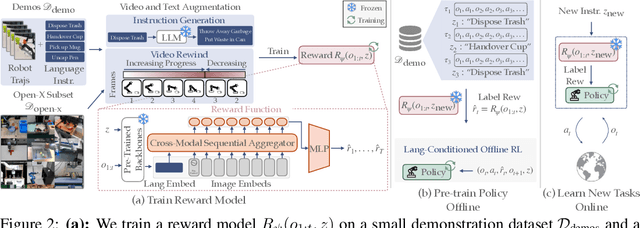

Abstract:We introduce ReWiND, a framework for learning robot manipulation tasks solely from language instructions without per-task demonstrations. Standard reinforcement learning (RL) and imitation learning methods require expert supervision through human-designed reward functions or demonstrations for every new task. In contrast, ReWiND starts from a small demonstration dataset to learn: (1) a data-efficient, language-conditioned reward function that labels the dataset with rewards, and (2) a language-conditioned policy pre-trained with offline RL using these rewards. Given an unseen task variation, ReWiND fine-tunes the pre-trained policy using the learned reward function, requiring minimal online interaction. We show that ReWiND's reward model generalizes effectively to unseen tasks, outperforming baselines by up to 2.4x in reward generalization and policy alignment metrics. Finally, we demonstrate that ReWiND enables sample-efficient adaptation to new tasks, beating baselines by 2x in simulation and improving real-world pretrained bimanual policies by 5x, taking a step towards scalable, real-world robot learning. See website at https://rewind-reward.github.io/.
From Flatland to Space: Teaching Vision-Language Models to Perceive and Reason in 3D
Mar 29, 2025
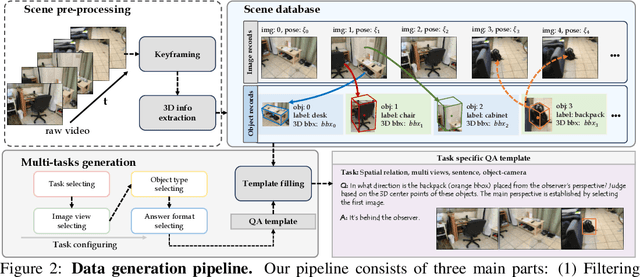

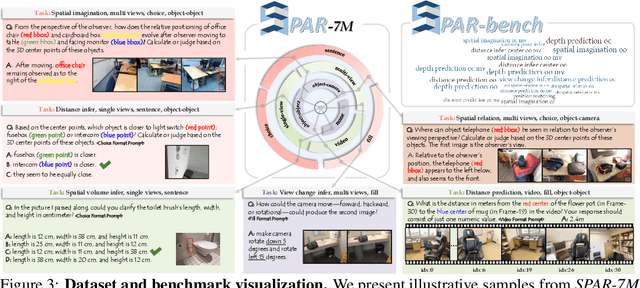
Abstract:Recent advances in LVLMs have improved vision-language understanding, but they still struggle with spatial perception, limiting their ability to reason about complex 3D scenes. Unlike previous approaches that incorporate 3D representations into models to improve spatial understanding, we aim to unlock the potential of VLMs by leveraging spatially relevant image data. To this end, we introduce a novel 2D spatial data generation and annotation pipeline built upon scene data with 3D ground-truth. This pipeline enables the creation of a diverse set of spatial tasks, ranging from basic perception tasks to more complex reasoning tasks. Leveraging this pipeline, we construct SPAR-7M, a large-scale dataset generated from thousands of scenes across multiple public datasets. In addition, we introduce SPAR-Bench, a benchmark designed to offer a more comprehensive evaluation of spatial capabilities compared to existing spatial benchmarks, supporting both single-view and multi-view inputs. Training on both SPAR-7M and large-scale 2D datasets enables our models to achieve state-of-the-art performance on 2D spatial benchmarks. Further fine-tuning on 3D task-specific datasets yields competitive results, underscoring the effectiveness of our dataset in enhancing spatial reasoning.
SOGS: Second-Order Anchor for Advanced 3D Gaussian Splatting
Mar 10, 2025Abstract:Anchor-based 3D Gaussian splatting (3D-GS) exploits anchor features in 3D Gaussian prediction, which has achieved impressive 3D rendering quality with reduced Gaussian redundancy. On the other hand, it often encounters the dilemma among anchor features, model size, and rendering quality - large anchor features lead to large 3D models and high-quality rendering whereas reducing anchor features degrades Gaussian attribute prediction which leads to clear artifacts in the rendered textures and geometries. We design SOGS, an anchor-based 3D-GS technique that introduces second-order anchors to achieve superior rendering quality and reduced anchor features and model size simultaneously. Specifically, SOGS incorporates covariance-based second-order statistics and correlation across feature dimensions to augment features within each anchor, compensating for the reduced feature size and improving rendering quality effectively. In addition, it introduces a selective gradient loss to enhance the optimization of scene textures and scene geometries, leading to high-quality rendering with small anchor features. Extensive experiments over multiple widely adopted benchmarks show that SOGS achieves superior rendering quality in novel view synthesis with clearly reduced model size.
VidSketch: Hand-drawn Sketch-Driven Video Generation with Diffusion Control
Feb 03, 2025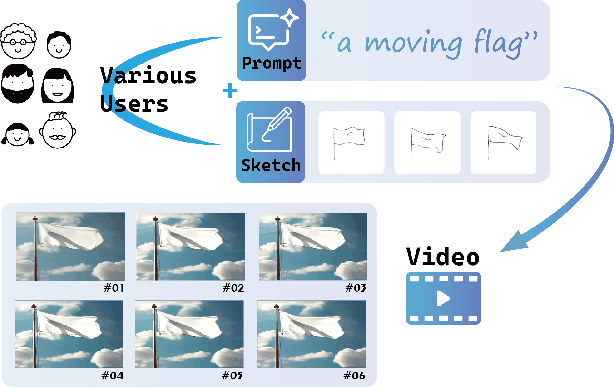
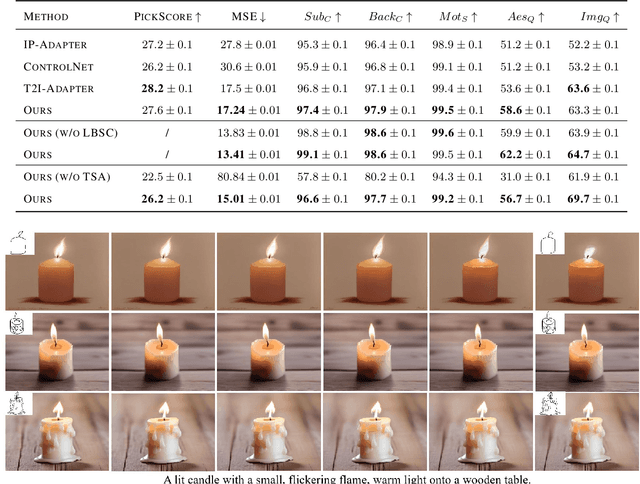
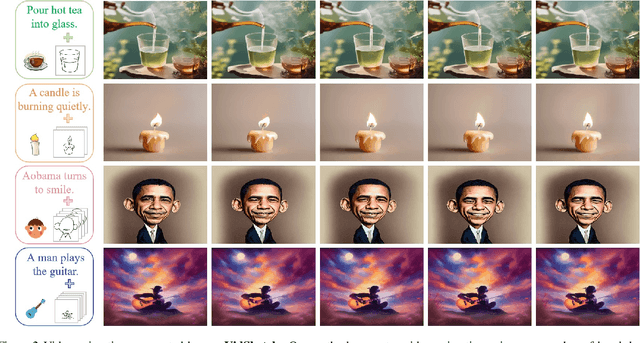

Abstract:With the advancement of generative artificial intelligence, previous studies have achieved the task of generating aesthetic images from hand-drawn sketches, fulfilling the public's needs for drawing. However, these methods are limited to static images and lack the ability to control video animation generation using hand-drawn sketches. To address this gap, we propose VidSketch, the first method capable of generating high-quality video animations directly from any number of hand-drawn sketches and simple text prompts, bridging the divide between ordinary users and professional artists. Specifically, our method introduces a Level-Based Sketch Control Strategy to automatically adjust the guidance strength of sketches during the generation process, accommodating users with varying drawing skills. Furthermore, a TempSpatial Attention mechanism is designed to enhance the spatiotemporal consistency of generated video animations, significantly improving the coherence across frames. You can find more detailed cases on our official website.
HuViDPO:Enhancing Video Generation through Direct Preference Optimization for Human-Centric Alignment
Feb 02, 2025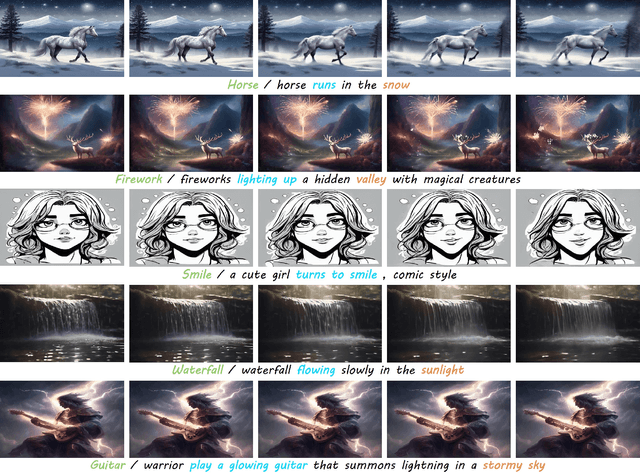
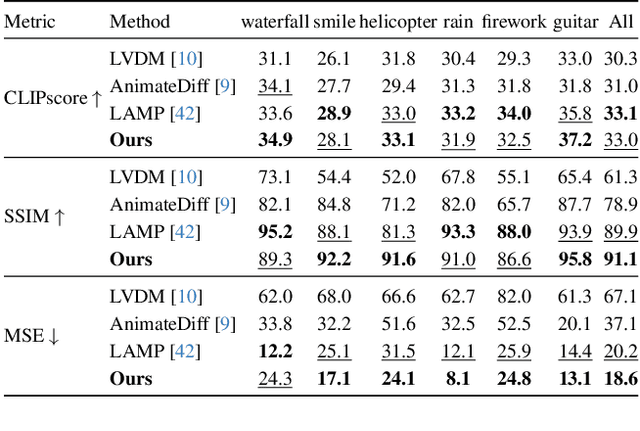
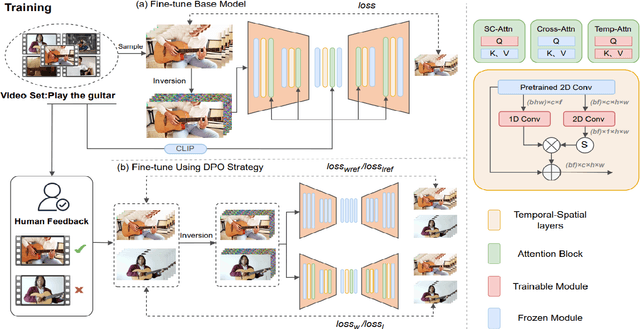

Abstract:With the rapid development of AIGC technology, significant progress has been made in diffusion model-based technologies for text-to-image (T2I) and text-to-video (T2V). In recent years, a few studies have introduced the strategy of Direct Preference Optimization (DPO) into T2I tasks, significantly enhancing human preferences in generated images. However, existing T2V generation methods lack a well-formed pipeline with exact loss function to guide the alignment of generated videos with human preferences using DPO strategies. Additionally, challenges such as the scarcity of paired video preference data hinder effective model training. At the same time, the lack of training datasets poses a risk of insufficient flexibility and poor video generation quality in the generated videos. Based on those problems, our work proposes three targeted solutions in sequence. 1) Our work is the first to introduce the DPO strategy into the T2V tasks. By deriving a carefully structured loss function, we utilize human feedback to align video generation with human preferences. We refer to this new method as HuViDPO. 2) Our work constructs small-scale human preference datasets for each action category and fine-tune this model, improving the aesthetic quality of the generated videos while reducing training costs. 3) We adopt a First-Frame-Conditioned strategy, leveraging the rich in formation from the first frame to guide the generation of subsequent frames, enhancing flexibility in video generation. At the same time, we employ a SparseCausal Attention mechanism to enhance the quality of the generated videos.More details and examples can be accessed on our website: https://tankowa.github.io/HuViDPO. github.io/.
Learning an Adaptive Fall Recovery Controller for Quadrupeds on Complex Terrains
Dec 22, 2024Abstract:Legged robots have shown promise in locomotion complex environments, but recovery from falls on challenging terrains remains a significant hurdle. This paper presents an Adaptive Fall Recovery (AFR) controller for quadrupedal robots on challenging terrains such as rocky, breams, steep slopes, and irregular stones. We leverage deep reinforcement learning to train the AFR, which can adapt to a wide range of terrain geometries and physical properties. Our method demonstrates improvements over existing approaches, showing promising results in recovery scenarios on challenging terrains. We trained our method in Isaac Gym using the Go1 and directly transferred it to several mainstream quadrupedal platforms, such as Spot and ANYmal. Additionally, we validated the controller's effectiveness in Gazebo. Our results indicate that the AFR controller generalizes well to complex terrains and outperforms baseline methods in terms of success rate and recovery speed.
FreGS: 3D Gaussian Splatting with Progressive Frequency Regularization
Mar 11, 2024


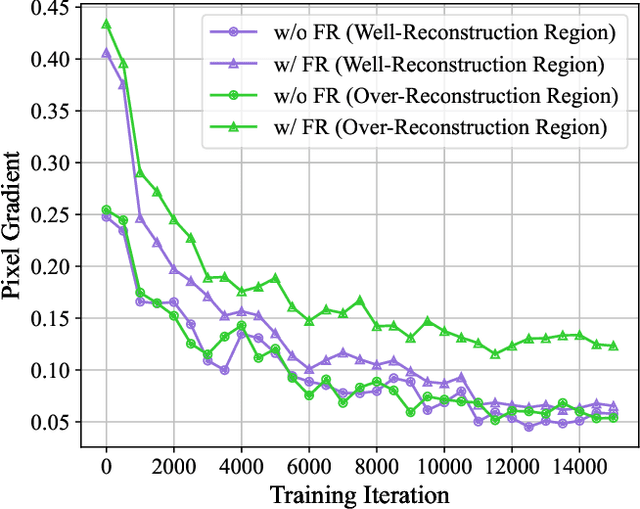
Abstract:3D Gaussian splatting has achieved very impressive performance in real-time novel view synthesis. However, it often suffers from over-reconstruction during Gaussian densification where high-variance image regions are covered by a few large Gaussians only, leading to blur and artifacts in the rendered images. We design a progressive frequency regularization (FreGS) technique to tackle the over-reconstruction issue within the frequency space. Specifically, FreGS performs coarse-to-fine Gaussian densification by exploiting low-to-high frequency components that can be easily extracted with low-pass and high-pass filters in the Fourier space. By minimizing the discrepancy between the frequency spectrum of the rendered image and the corresponding ground truth, it achieves high-quality Gaussian densification and alleviates the over-reconstruction of Gaussian splatting effectively. Experiments over multiple widely adopted benchmarks (e.g., Mip-NeRF360, Tanks-and-Temples and Deep Blending) show that FreGS achieves superior novel view synthesis and outperforms the state-of-the-art consistently.
WoVoGen: World Volume-aware Diffusion for Controllable Multi-camera Driving Scene Generation
Dec 06, 2023



Abstract:Generating multi-camera street-view videos is critical for augmenting autonomous driving datasets, addressing the urgent demand for extensive and varied data. Due to the limitations in diversity and challenges in handling lighting conditions, traditional rendering-based methods are increasingly being supplanted by diffusion-based methods. However, a significant challenge in diffusion-based methods is ensuring that the generated sensor data preserve both intra-world consistency and inter-sensor coherence. To address these challenges, we combine an additional explicit world volume and propose the World Volume-aware Multi-camera Driving Scene Generator (WoVoGen). This system is specifically designed to leverage 4D world volume as a foundational element for video generation. Our model operates in two distinct phases: (i) envisioning the future 4D temporal world volume based on vehicle control sequences, and (ii) generating multi-camera videos, informed by this envisioned 4D temporal world volume and sensor interconnectivity. The incorporation of the 4D world volume empowers WoVoGen not only to generate high-quality street-view videos in response to vehicle control inputs but also to facilitate scene editing tasks.
Bootstrap Your Own Skills: Learning to Solve New Tasks with Large Language Model Guidance
Oct 17, 2023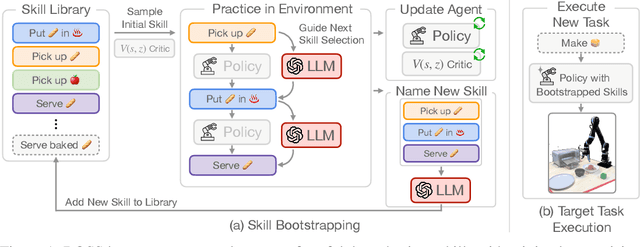
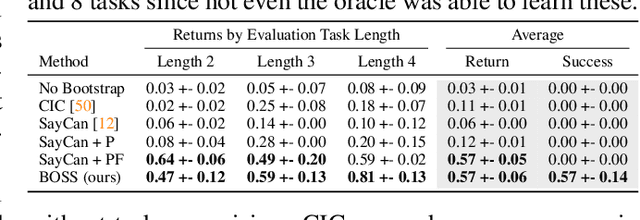
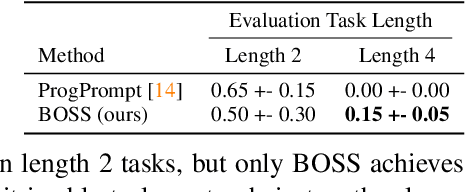
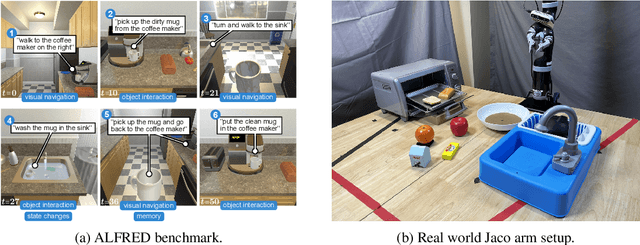
Abstract:We propose BOSS, an approach that automatically learns to solve new long-horizon, complex, and meaningful tasks by growing a learned skill library with minimal supervision. Prior work in reinforcement learning require expert supervision, in the form of demonstrations or rich reward functions, to learn long-horizon tasks. Instead, our approach BOSS (BOotStrapping your own Skills) learns to accomplish new tasks by performing "skill bootstrapping," where an agent with a set of primitive skills interacts with the environment to practice new skills without receiving reward feedback for tasks outside of the initial skill set. This bootstrapping phase is guided by large language models (LLMs) that inform the agent of meaningful skills to chain together. Through this process, BOSS builds a wide range of complex and useful behaviors from a basic set of primitive skills. We demonstrate through experiments in realistic household environments that agents trained with our LLM-guided bootstrapping procedure outperform those trained with naive bootstrapping as well as prior unsupervised skill acquisition methods on zero-shot execution of unseen, long-horizon tasks in new environments. Website at clvrai.com/boss.
Pose-Free Neural Radiance Fields via Implicit Pose Regularization
Aug 29, 2023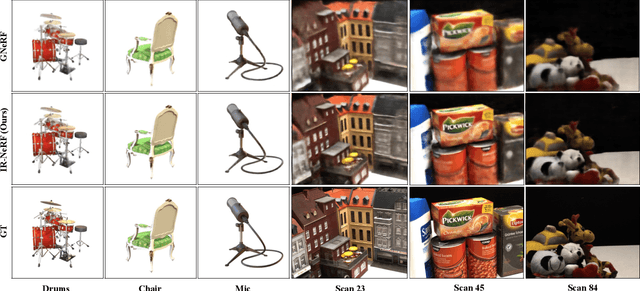
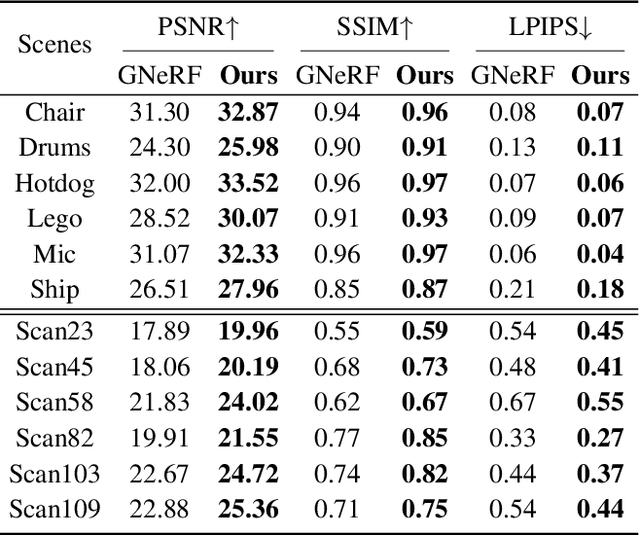
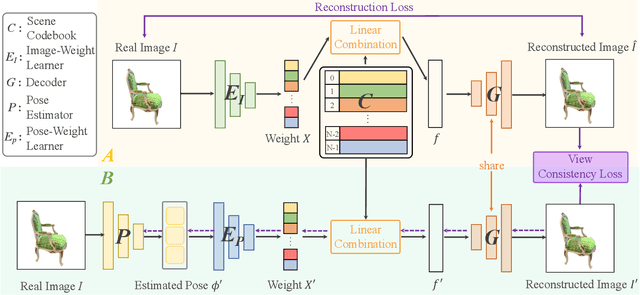

Abstract:Pose-free neural radiance fields (NeRF) aim to train NeRF with unposed multi-view images and it has achieved very impressive success in recent years. Most existing works share the pipeline of training a coarse pose estimator with rendered images at first, followed by a joint optimization of estimated poses and neural radiance field. However, as the pose estimator is trained with only rendered images, the pose estimation is usually biased or inaccurate for real images due to the domain gap between real images and rendered images, leading to poor robustness for the pose estimation of real images and further local minima in joint optimization. We design IR-NeRF, an innovative pose-free NeRF that introduces implicit pose regularization to refine pose estimator with unposed real images and improve the robustness of the pose estimation for real images. With a collection of 2D images of a specific scene, IR-NeRF constructs a scene codebook that stores scene features and captures the scene-specific pose distribution implicitly as priors. Thus, the robustness of pose estimation can be promoted with the scene priors according to the rationale that a 2D real image can be well reconstructed from the scene codebook only when its estimated pose lies within the pose distribution. Extensive experiments show that IR-NeRF achieves superior novel view synthesis and outperforms the state-of-the-art consistently across multiple synthetic and real datasets.
 Add to Chrome
Add to Chrome Add to Firefox
Add to Firefox Add to Edge
Add to Edge